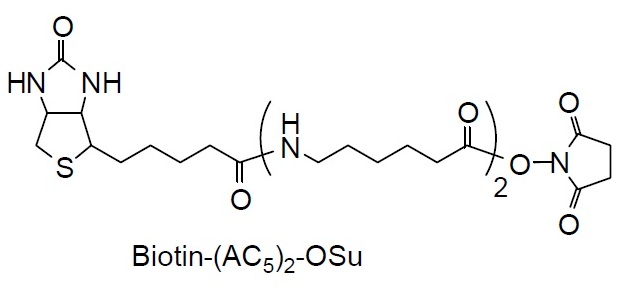Biotin-(AC5)2-OSu

Biotin Labeling Reagent
-
Product codeB306 Biotin-(AC5)2-OSu
-
CAS No.89889-52-1
-
Chemical name6-[6-(Biotinylamino)hexanoylamino]hexanoic acid N-hydroxysuccinimide ester
-
MWC26H41NO7S=567.7
| Unit size | Price | Item Code |
|---|---|---|
| 10 mg | B306-10 |
Description
Product Description of Amine-Reactive Biotins
The avidin-biotin system has many applications in immunology and histochemistry. The interaction between avidin and biotin is remarkably strong with a dissociation constant on the order of 10-15 M. Biotin is usually added to primary or secondary antibodies such as anti-IgG and anti-IgM. After preparing the antigen-antibody complex with the biotin-labeled antibody, colorimetric, or fluorometric detection of the antigen is performed using enzyme or fluorescein-labeled avidin or streptavidin. Succinimidyl ester biotins react with primary and secondary amines, such as amino acids and proteins, at pH 7-9. Succinimidyl ester reacts with free amine groups to create a stable amide bond. Succinimidyl biotin reagents must be dissolved in DMSO, DMF, or alcohol. Stock solutions prepared with DMSO are stable for several months at -20ºC. Sulfo succinimidyl biotin reagents are soluble in water, so there is no need to use organic solvents such as DMF or DMSO. IgG prepared using biotin with a longer spacer such as Biotin-(AC5)2-OSu or Biotin-(AC5)2-Sulfo-OSu, has a better signal-to-noise ratio. The longer spacer enables streptavidin or anti-biotin IgG to recognize biotin without structural inhibition. Therefore, Biotin-(AC5)2-OSu is utilized as the biotin labeling agent in the Biotin Labeling Kit-NH2.
Structure

Technical info
Labeling Procedure for IgG
1. Prepare 10 mM of the biotin labeling reagent using DMSO.
2. Prepare 100 μl of 1 mg per ml IgG buffer solution (pH 7.5-8.5) that does not contain any large molecules with amine compounds.
3. Add 1-5ml biotin labeling reagent DMSO solution to the IgG buffer solution and incubate at 37ºC for 1 hour.
4. Remove excess biotin labeling reagent using gel filtration or dialysis.
5. Prepare solutions for further experiment using an appropriate buffer such as PBST (0.05% Tween 20/PBS).
References
1) P. Kongtawelert and P. Ghosh, "A New Sandwich-ELISA Method for the Determination of Keratan Sulphate Peptides in Biological Fluids Employing a Monoclonal Antibody and Labelled Avidin Biotin Technique.", Clin. Chem. Acta,, 1990, 195, 17.
2) G. Paganelli, S. Pervez, A. G. Siccardi, G. Rowlinson, G. Deleide, F. Chiolerio, M. Malcovati, G. A. Scassllati and A. A. Epenetos, "Intraperitoneal Radio-localization of Tumors Pre-targeted by Biotinylated Monoclonal Antibodies", Int. J. Cancer, 1990, 45, 1184.
3) C. Wagener, U. Kruger and J. E. Shively, "Selective Precipitation of Biotin-labeled Antigens or Monoclonal Antibodies by Avidin for Determining Epitope Specificities and Affinities in Solution-phase Assays", Methods Enzymol., 1990, 184, 518.
4) D. M. Boorsma, J. Van Bommel and E. M. Vander Raaij-Helmer, "Simultaneous Immunoenzyme Double Labelling Using Two Different Enzymes Linked Directly to Monoclonal Antibodies or with Biotin-avidin", J. Microscopy, 1986, 143, 197.
5) A. Komura, T. Tokuhisa, T. Nakagawa, A. Sasase, M. Ichihashi, S. Ferrone and Y. Mishima, "Specific Killing of Human Melanoma Cells with an Efficient 10B-compound on Monoclonal Antibodies", Pigment Cell Res., 1989, 2, 259.
6) R. Rappuoli, P. Leoncini, P. Tarli and P. Neri, "Competitive Enzyme Immunoassay for Human Chorionic Somatomammotropin Using the Avidin-biotin System", Anal. Biochem., 1981, 118, 168.
Handling and storage condition
| Appearance: | White to slightly yellow powder |
|---|---|
| Purity (HPLC): | ≧90.0% |
| Solubility in Dimethyl sulfoxide: | To passed test (clear, colorless to slightly yellow) |
| IR spectrum: | Authentic |
| NMR spectrum: | Authentic |
| -20°C |












